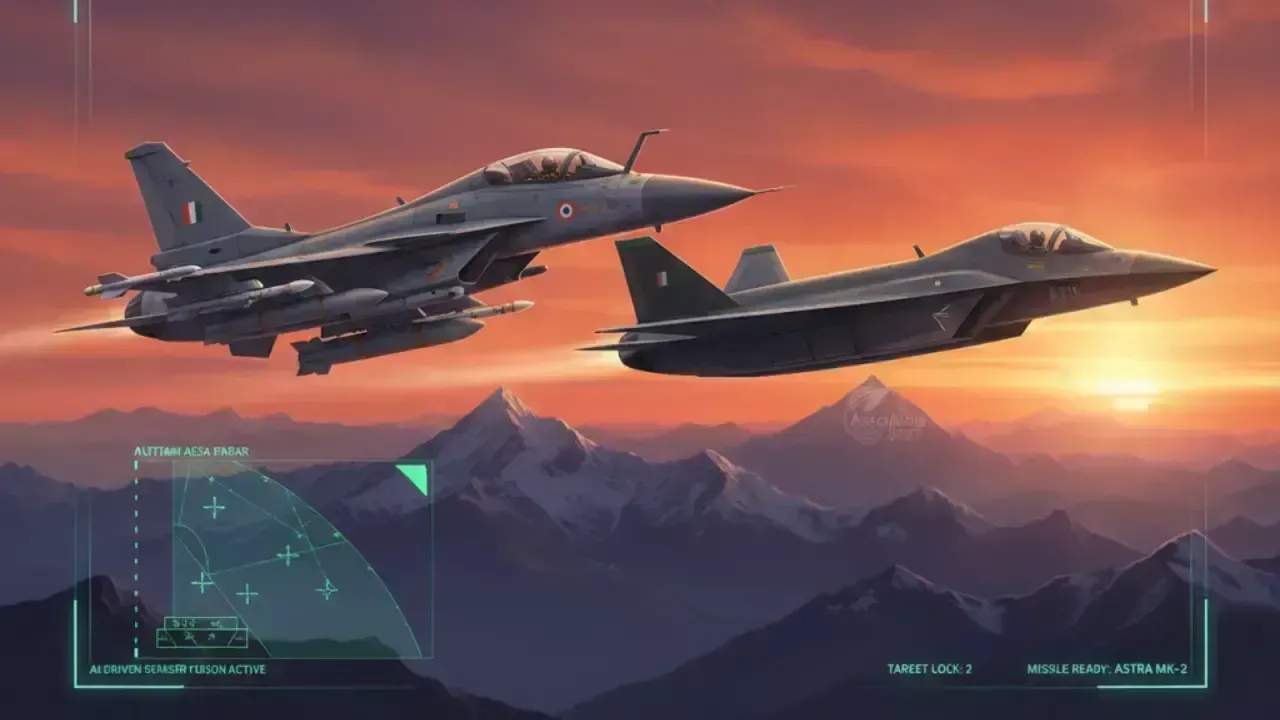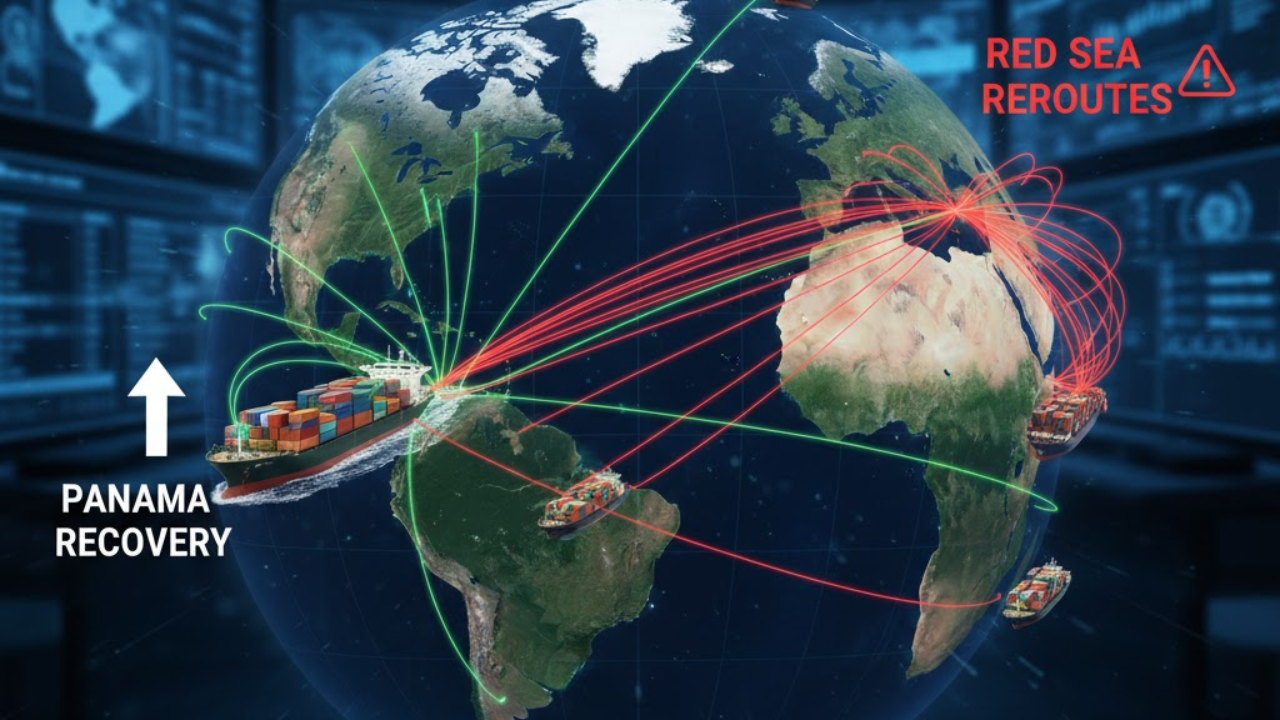
Post by : Shivani
India's aerospace ambitions are soaring to new heights in 2025, driven by the indigenous **Tejas Mk-2** and **Advanced Medium Combat Aircraft (AMCA)** programs. These next-generation fighter jets are pivotal to the Indian Air Force's (IAF) modernization, addressing critical gaps in squadron strength and countering regional threats from China and Pakistan. As of October 2025, the **Tejas Mk-2 development timeline** is accelerating toward prototype rollout, while the **AMCA project update 2025** highlights breakthroughs in stealth technology and public-private partnerships. With indigenous content targets of 82% for Mk-2 and 75-85% for AMCA, these programs embody **Atmanirbhar Bharat** (self-reliant India), positioning the nation as a global aerospace contender. This comprehensive 9,000-word article explores their technical advancements, strategic importance, procurement strategies, and challenges, offering insights for enthusiasts, policymakers, and industry stakeholders seeking the latest on **Indian fighter jets procurement 2025**.
India's aerial defense landscape is under strain, with the IAF operating 31 squadrons against a sanctioned strength of 42, a deficit exacerbated by the phased retirement of aging MiG-21s and the growing capabilities of adversaries like China's J-20 stealth fighters. The **Tejas Mk-2** and **AMCA** are tailored to address these challenges, offering multirole versatility and fifth-generation stealth, respectively. These programs align with India's strategic pivot toward self-reliance, reducing dependence on foreign imports like the Rafale while enhancing deterrence in a volatile Indo-Pacific region.
The IAF's operational readiness is challenged by a shrinking fleet and evolving threats. By October 2025, the IAF fields approximately 260 Su-30MKIs (13 squadrons), 36 Rafales, 50 Mirage 2000s, 60 Jaguars, and 70 MiG-29s, alongside 40 Tejas Mk-1/1A jets. However, MiG-21 retirements (down to 60 from 200 in 2015) have reduced squadron strength, with projections indicating a further dip to 29 by 2030 without new inductions. Tensions along the Line of Actual Control (LAC) with China, which operates over 300 J-20s and advanced air defenses, and Pakistan's potential acquisition of 40 J-35 stealth fighters underscore the urgency for modern platforms.
The **Tejas Mk-2**, a 4.5-generation multirole fighter, is designed to replace Mirage 2000s, MiG-29s, and Jaguars, offering enhanced range, payload, and avionics for air superiority and ground attack missions. The **AMCA**, a fifth-generation stealth platform, targets deep-strike capabilities against fortified targets, rivaling global peers like the F-35 and J-20. Both programs support **Atmanirbhar Bharat**, with high indigenous content (82% for Mk-2, 75-85% for AMCA) and local manufacturing, reducing lifecycle costs and fostering technological sovereignty.
India's **fighter jets procurement 2025** strategy balances indigenous production with selective imports. In September 2025, a $7 billion contract for 97 Tejas Mk-1A jets was signed, with deliveries starting mid-2025 to replace MiG-21s. The Multi-Role Fighter Aircraft (MRFA) tender for 114 jets, expected to invite bids in Q1 2025, may favor additional Rafales (36 in service, 40 more sought) or Lockheed Martin's F-21, with an estimated cost of ₹1.2 lakh crore. Naval procurement includes 26 Rafale-M jets ($7.4 billion) for INS Vikrant, with deliveries from 2028. Tejas Mk-2 (120 units by 2034) and AMCA (125+ by 2040) form the long-term backbone, ensuring a mix of 4.5- and 5th-gen capabilities.
China's expanding J-20 fleet (projected at 300+ by 2030) and Pakistan's interest in China's J-35, potentially fielding 40 units, pose significant threats. India's indigenous fighters must counter advanced air defenses like the S-400 (deployed by China and India) and integrate with network-centric warfare systems. The Tejas Mk-2's versatility and AMCA's stealth are critical to maintaining air superiority and deterrence in two-front scenarios.
The **HAL Tejas Mk-2**, developed by the Aeronautical Development Agency (ADA) and manufactured by Hindustan Aeronautics Limited (HAL), is a 4.5-generation multirole fighter designed to address IAF requirements unmet by the Tejas Mk-1/1A. With a maximum takeoff weight of 17.5 tons, it offers superior range, payload, and avionics, positioning it as a cost-effective alternative to imported jets like the Rafale ($200 million/unit vs. Mk-2's $50-60 million). As of October 2025, the program is 60% complete on its first prototype, with rollout planned for November-December 2025.
The **Tejas Mk-2 design** incorporates significant upgrades over the Mk-1A, making it a formidable multirole platform. Its airframe, stretched to accommodate close-coupled canards, enhances agility and lift, enabling a combat radius of 1,500 km (50% more than Mk-1A's 500 km). The jet is powered by a single GE F414-INS6 engine (98 kN thrust), achieving Mach 1.8 and a top speed of 2,200 km/h. With 82% indigenous content (targeting 90% post-engine localization), it reduces reliance on foreign supply chains.
The Mk-2 features an advanced avionics suite, including the indigenous **Uttam GaN-based AESA radar** with 1,000+ transmit/receive modules, offering a 250 km detection range for fighter-sized targets. Integrated Infrared Search and Track (IRST) enables passive targeting, while the Dhruti electronic warfare (EW) suite, developed by DRDO, provides jamming and countermeasure capabilities. The jet's 11 hardpoints support a 6,500 kg payload, including indigenous weapons like the Astra Mk-1/2 BVRAAM (110-160 km range), BrahMos-NG air-launched cruise missile, Rudram anti-radiation missiles, and Spice-2000 precision-guided bombs, ensuring versatility across air-to-air, air-to-ground, and anti-ship roles.
The GE F414-INS6 engine, delivering 98 kN thrust, supports supercruise capabilities (Mach 1.2 without afterburners). HAL is negotiating with GE for 90% indigenization by 2030, with eight engines delivered by October 2025. Stealth enhancements include a reduced radar cross-section (RCS) through composite materials (40% of airframe), radar-absorbent coatings, and a canard-delta configuration that minimizes frontal RCS. These features position Mk-2 as a "near-stealth" platform, bridging the gap to AMCA.
The Mk-2 significantly outclasses the Mk-1A, as shown below:
| Feature | Tejas Mk-1A | Tejas Mk-2 |
|---|---|---|
| Max Takeoff Weight | 13.5 tons | 17.5 tons |
| Engine Thrust | 90 kN | 98 kN |
| Combat Radius | 500 km | 1,500 km |
| Payload Capacity | 3,500 kg | 6,500 kg |
| Radar | EL/M-2052 or Uttam AESA | Uttam GaN AESA |
| Indigenous Content | 70% | 82% (90% post-engine) |
| Hardpoints | 8 | 11 |
This comparison highlights Mk-2's role as a true multirole platform, capable of replacing Mirage 2000s and Jaguars.
Initiated in 2007, the **Tejas Mk-2 development timeline** faced delays due to funding (₹10,000 crore cleared in 2022) and engine supply issues. By October 2025, significant progress includes:
Aero India 2025 showcased a 1:15 scale model, attracting interest from 16 nations, including Argentina, Egypt, and Malaysia, for potential exports.
Metal cutting for the first prototype began in February 2025, with HAL leveraging its Mk-1A production line (first delivery March 2024) for efficiency. Eight GE F414 engines have been delivered, and assembly of critical components like canards and avionics bays is on track. The focus is on integrating the Uttam AESA radar and Dhruti EW suite, with ground testing slated for Q4 2025.
Delays in subsystems, particularly the Uttam radar's GaN module validation, have been mitigated by increased funding (₹2,500 crore allocated in 2025) and HAL's experience with Mk-1A production. Supply chain disruptions, notably from the Ukraine war affecting titanium supplies, are being addressed through local sourcing and partnerships with private firms like Tata Advanced Systems.
The Tejas Mk-2's cost-effectiveness ($50-60 million/unit) and multirole capabilities make it attractive for export markets. Aero India 2025 highlighted interest from 16 nations, with HAL exploring co-production models to boost India's defense export share, currently at ₹16,000 crore annually.
The **Advanced Medium Combat Aircraft (AMCA)** is India's ambitious fifth-generation stealth fighter, designed to rival the F-35 and J-20. A 25-tonne twin-engine platform, it emphasizes supercruise (Mach 1.5 without afterburners), low radar cross-section (<0.5 m²), and network-centric warfare. As of October 2025, the program is advancing post-design freeze, with prototype development underway.
The **AMCA fighter jet features** a stealth-optimized design with S-shaped intakes, internal weapons bays (1,500 kg stealth load, 5,500 kg external), and radar-absorbent materials (RAM). Diverterless supersonic inlets (DSI) reduce RCS, while 75-85% indigenous content ensures self-reliance. AI-driven sensor fusion integrates data from multiple sensors, enhancing situational awareness.
The AMCA's avionics suite includes the Uttam GaN AESA radar, IRST for passive detection, and a Gallium Nitride-based EW suite for jamming enemy radars. Sensor fusion, supported by an AI-driven mission computer, provides 360° awareness, while integrated vehicle health monitoring predicts maintenance needs, reducing downtime. The cockpit features large-area displays and electronic piloting, completed in September 2025, for automated threat response.
Internal weapons bays carry Astra Mk-2/3 BVRAAMs (160-200 km range), BrahMos-NG, and Rudram-3 anti-radiation missiles, ensuring stealthy strikes. External hardpoints support heavier loads for non-stealth missions. With a 55,000 ft ceiling and 6,500 kg fuel capacity, the AMCA achieves a 1,000 km combat radius, enhanced by supercruise for rapid deployment.
The AMCA Mk-1 uses two GE F414 engines (110 kN each), while Mk-2 will feature a 125 kN engine co-developed with Safran under a ₹61,000 crore agreement signed in August 2025. The deal includes full intellectual property rights (IPR) transfer, with 250 engines planned for production by 2035, ensuring long-term self-reliance.
The **AMCA project update 2025** reflects significant momentum. The Cabinet Committee on Security (CCS) approved ₹15,000 crore for five prototypes in March 2024, with the execution model cleared in May 2025 for public-private partnerships. Key milestones include:
The AMCA's design was frozen in February 2025, incorporating lessons from the Tejas program to streamline development. The bidding process, overseen by a DRDO-led committee under A Pillai, involves major players like HAL, Tata Advanced Systems, and Adani Defence, with shortlisting expected by December 2025. Prototype assembly will occur at HAL's Nashik facility, leveraging existing infrastructure.
The AMCA timeline targets a first flight in 2028, with 500-600 flight tests planned for certification. IOC is set for 2032, with full production by 2035 at 12-16 units/year, scaling to 20 by 2040. The Safran engine partnership, finalized in August 2025, ensures engine availability, with initial units produced in France and later localized in India.
Public-private synergy is central to AMCA, with firms like Godrej (actuators), Bharat Electronics (avionics), and L&T (airframe components) contributing. The Aero India 2025 display of a full-scale model underscored industry readiness, with DRDO targeting 50% private sector involvement in production.
India's **IAF modernization plan 2025** integrates indigenous and foreign platforms to achieve 42 squadrons by 2035. The $7 billion Tejas Mk-1A deal (97 units, deliveries from mid-2025) addresses immediate gaps, while the MRFA tender (114 jets, ₹1.2 lakh crore) and naval Rafale-M (26 units, $7.4 billion) provide interim solutions. Tejas Mk-2 (120 units by 2034) and AMCA (125+ by 2040) form the long-term core, with a total investment of ₹2 lakh crore for AMCA alone.
HAL's production strategy targets 24 Tejas Mk-2 units/year by 2032, supported by a new assembly line in Nashik. AMCA production, starting in 2035, will leverage private sector capacity, with Tata and Adani setting up parallel lines. Total costs include ₹1 lakh crore for Mk-2 and ₹15,000 crore for AMCA prototypes, with additional funds for infrastructure and R&D.
The MRFA tender, likely favoring Rafale or F-21, ensures interim 5th-gen capabilities until AMCA matures. The IAF plans 2-3 foreign 5th-gen squadrons by 2030, complementing 6 Mk-2 and 7 AMCA squadrons. Naval requirements include 26 Rafale-M jets by 2030, with a potential follow-on order for TEDBF (Twin-Engine Deck-Based Fighter).
The Tejas Mk-2 and AMCA programs are projected to generate over 10,000 direct jobs and 50,000 indirect jobs, boosting MSMEs in aerospace. Export potential, particularly for Mk-2, could add ₹20,000 crore to India's defense exports by 2035, enhancing economic self-reliance.
Global disruptions, such as the Ukraine war impacting titanium supplies, highlight vulnerabilities. DRDO and HAL are diversifying sources, with partnerships like Tata's composite manufacturing and Bharat Forge's forgings reducing import dependence to 10% by 2030.
The **Tejas Mk-2 and AMCA** are linchpins in countering China's J-20 and Pakistan's J-35, ensuring India's aerial dominance in a two-front scenario. Their indigenous design reduces strategic vulnerabilities, while exports enhance India's geopolitical influence.
The Mk-2's multirole capabilities suit high-intensity conflicts along the LAC and LoC, countering China's S-400 and J-20 with Astra missiles and EW suites. The AMCA's stealth enables penetration of contested airspace, neutralizing fortified targets with BrahMos-NG and Rudram-3.
Technologies like composites, GaN radars, and AI-driven avionics have applications in civil aviation, drones, and space systems. Exports of Mk-2 to ASEAN and African nations could position India as a rival to China's defense market share.
With 82-90% indigenous content, Mk-2 and AMCA embody India's self-reliance vision, reducing lifecycle costs by 30% compared to imports. Local production of F414 and Safran engines ensures strategic autonomy.
By 2035, the IAF will field 6 Mk-2 and 7 AMCA squadrons, achieving 42 squadrons and positioning India as a global aerospace leader, rivaling the US, China, and Russia.
As of October 2025, the **Tejas Mk-2** and **AMCA** programs mark a transformative phase in India's defense aviation. With Mk-2's prototype rollout imminent and AMCA's bidding process advancing, these jets promise to bolster IAF's capabilities while driving economic and technological growth. By 2035, they will anchor India's aerial dominance, embodying **Atmanirbhar Bharat** and cementing the nation's place in the global aerospace arena.
#TejasMk2 #AMCA #IndianFighterJets #IAFModernization #AtmanirbharBharat #FighterJetProcurement2025 #HALTejas #DRDOAMCA #IndianAerospace #5thGenFighter










Bengaluru-Mumbai Superfast Train Approved After 30-Year Wait
Railways approves new superfast train connecting Bengaluru and Mumbai, ending a 30-year demand, easi

Canada Post Workers Strike Halts Nationwide Mail and Parcel Services
Canada Post halts operations as CUPW strike disrupts mail and parcel delivery nationwide amid disput

PM Modi Launches BSNL ‘Swadeshi’ 4G Network, 97,500 Towers Built
India enters global telecom league as PM Modi inaugurates BSNL’s indigenous 4G, connecting 26,700 vi

India’s Iconic MiG‑21 Takes Final Flight After Six Decades of Service
After 60 years India retires its MiG‑21 fighter jet, a legendary yet controversial warplane marking

Hindustan Zinc unveils AI hotspot monitoring at Debari smelter
Hindustan Zinc launches AI-powered Switchyard Hotspot Monitoring at Debari smelter to cut outages bo

Chinese experts worked inside sanctioned Russian drone plant
Chinese drone specialists visited IEMZ Kupol supplying parts and drones via intermediaries, deepenin